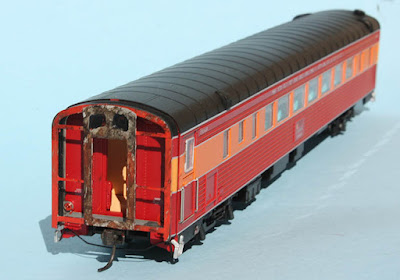In the preceding post in this series about full-width diaphragms, I spent some space showing the distinctive Pullman-Standard face plates used on many Southern Pacific lightweight passenger cars, especially after World War II. I also showed the making of a model version of such a face plate (you can see that post here: https://modelingthesp.blogspot.com/2021/08/full-width-diaphragms-part-3.html ).
To illustrate such diaphragms on a Daylight-decorated Broadway Limited coach, see this post: https://modelingthesp.blogspot.com/2021/08/full-width-diaphragms-part-2.html . Adding one of the so-called “opera window” face plates to one of those cars looks like this (with added grease and rust on the face plate):
Now this car could operate at the end of a train and look correct. Note that as usual, the color stripes on the car side carry onto the diaphragm. The one shortcoming here is that the folded-bellows of the inner diaphragm itself is absent. That’s fine in a complete consist, in which one only sees the sides of cars, but not really okay in the final car in a train. I will add something here.
The Broadway Limited cars are beautifully decorated for Daylight use, but other trains, including the Lark equipment that I operate, obviously need different paint.
Let me spend a few sentences on the Lark. Until the summer of 1956, the Lark remained essentially the all-Pullman train it had become when it was streamlined in 1941, and it still had its round-end observation cars. It did have some new postwar sleepers but primarily retained its 1941 equipment.
Conveniently, I model the early 1950s, when striping on Lark cars had been decreased to just the boundary between light gray and dark gray, omitting the earlier stripes at the top and bottom of the car side. Below you see an AHM 10-6 sleeper (what AHM called a “1930 Sleeper”) painted for Lark.
Note above that the dark window band doesn’t extend across the door. This was how the Lark cars were delivered, and well into the 1950s the majority of the cars continued in that appearance.
The car above clearly needs to have a representation of a full-width diaphragm added. The diaphragms had the same striping as the car side, as noted above (for a photo, see: https://modelingthesp.blogspot.com/2021/07/the-challenge-of-full-width-diaphragms.html ).
One can readily add the needed Dark Gray and Light Gray with a brush. In my modeling, I have used Floquil “Lark Dark Gray” as it came from the bottle, but lightened the Floquil “Lark Light Gray” to the shade you see above, to look more like prototype photos in sunlight.
As I’ve mentioned before, a complication with these AHM cars is that they have a heavy “lip” around the end doors but no actual diaphragm. I decided to use the outer “shell” of the American Limited diaphragm kit (that kit is discussed in the post linked in the second paragraph of the present post). Below, it’s shown installed, but inside-out to fit the AHM car end, because of the heavy door surround.
Next the interior of the extended end (the light gray plastic, above) is painted Lark Dark Gray, along with the window stripe on the outside:
Then the top of the extension is painted black, to match the roof, and the lighter side areas (Lark Light Gray) are painted. The separation stripes were left in the very light gray original plastic color, which looked much like the color of my decal “white” stripes.
Finally, the American Limited part contains quite a good striker plate. I separated it from the door shape of the part, and painted it medium gray (rust and grease marks were added with artist’s pencils).
This car is now suited for operation at the end of a passenger train. I will continue to explore ways to use the various commercial diaphragm parts, for both full-width and conventional diaphragms, to improve my passenger equipment.
Tony Thompson

















































